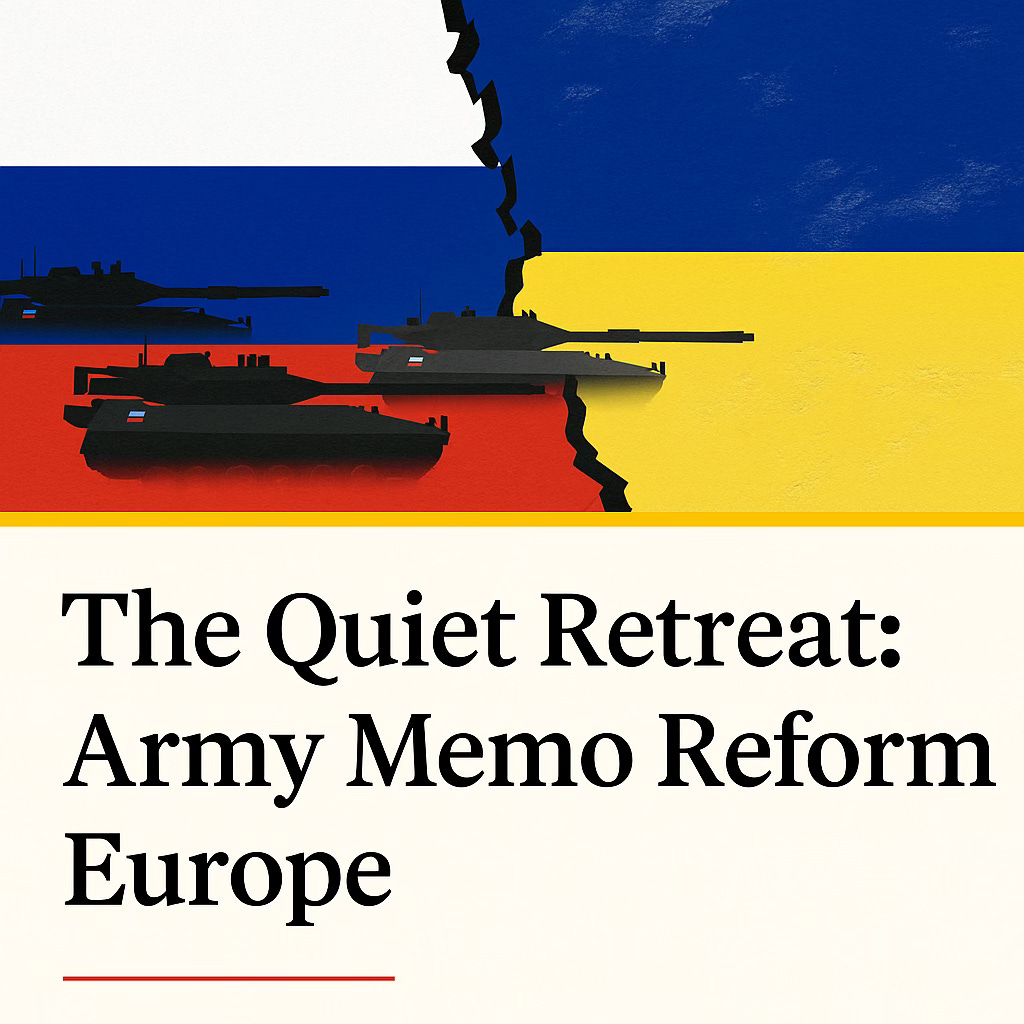🇺🇸 The Quiet Retreat: Army Reform Memo Signals Withdrawal from Europe
Officially, it’s modernization. In reality, it may be a strategic retreat.
The Gist:
In May 2025, the Army released a transformation memo that cancels legacy programs, downsizes aviation units, and shifts focus to large-scale combat against “peer adversaries.” This article cross-references the memo with expert analysis from Just Security to unpack what’s really happening—and why it could leave NATO exposed and Europe vulnerable.
On May 1, 2025, the U.S. Army released a sweeping policy document titled Army Transformation and Acquisition Reform (PDF). The memo outlines a bold vision to “win the first fight fast” by cutting legacy systems, eliminating brigades, and re-engineering force structure.
To some, it sounds like progress. But when you compare that memo with expert analysis—especially Jennifer Kavanagh’s breakdown in Just Security—a more troubling picture comes into focus.
This isn’t just reform. It’s a retreat from Europe. A quiet shift that leaves NATO exposed, and assumes tomorrow’s war will look nothing like the one burning now in Ukraine.
🔁 Cross-Referenced Analysis: Army Memo vs.
Just Security
🛠️ 1. The Cuts Are Real—but Risky
Army Memo: Terminates 24 programs, cancels over 37,000 pieces of equipment—including JLTVs, UH-60s, and the Future Attack Reconnaissance Aircraft (FARA).
Just Security: These aren’t just paper cuts—they’re front-line tools that NATO has come to rely on.
🔍 Think about it: Modernization always carries risk. This time, it’s the risk of being unready in the region that still sees live combat.
📉 2. Aviation Losses Undermine NATO Agility
Army Memo: Eliminates two combat aviation brigades, halts FARA and CH-47F Block II for conventional forces, and redirects funds to AI, sensing, and long-range fires.
Just Security: Combat aviation is NATO’s connective tissue—its speed, its reach, its lifeline. Pulling it back now weakens allied deterrence.
🔍 Think about it: The next crisis may not wait for new tech to arrive. It will demand the assets we just shelved.
In the Navy, I was in a training squadron—but I remember we constantly cannibalized one aircraft to get another in the air. It worked, but barely. And that was during peacetime. If this transformation leads to smaller fleets with no margin for parts, we’re risking a future where “combat ready” is theoretical on paper—but grounded on the tarmac. I’d hate to see modernization push us back into that position.
🇨🇳 3. Focus on China, While Russia Reloads
Army Memo: Uses the term “peer adversary” repeatedly but never names Russia—not once.
Just Security: That silence is telling. The document orients the Army for the Indo-Pacific while treating the European threat like an afterthought.
🔍 Think about it: We’re preparing for a hypothetical war and shedding the capabilities needed for the one that already exists.
⚖️ 4. No Strategic Justification or Risk Breakdown
Army Memo: Frames transformation as necessary for agility and innovation but provides no regional risk analysis.
Just Security: Highlights this omission. The memo says what’s changing—but not why it’s safe to change it.
🔍 Think about it: If deterrence in Europe still matters, where’s the proof that this plan doesn’t weaken it?
🤝 5. Hope That Europe Will “Step Up”—Without a Net
Army Memo: States that the Army will be “more ready and sustainable,” but cuts forward-facing assets.
Just Security: Points out that most NATO allies don’t have the capacity to replace U.S. lift, fires, and forward command.
🔍 Think about it: You don’t shift the burden mid-crisis—especially not without a backup plan.
🧭 Final Assessment: NATO, Strategy, and What We Lose
This memo signals more than reform—it signals retreat.
We’re giving up proven capabilities in Europe to prepare for a different war in a different region. We’re talking about AI and software factories while NATO’s eastern flank still needs helicopters, armor, and boots that can move fast.
The Army says it’s preparing to win “the first fight fast.” But which fight? And what if it’s already begun?
Sources:
🧭 Stay Informed. Stay Resilient.
If you found this useful, please consider subscribing or sharing. This newsletter exists to break down quiet decisions before they become irreversible damage.
👉 Visit Tbird’s Quiet Fight for more investigations and insights.
If this piece resonated with you—or raised concerns others should hear—please share it.
Your voice helps push quiet policy into public conversation.



